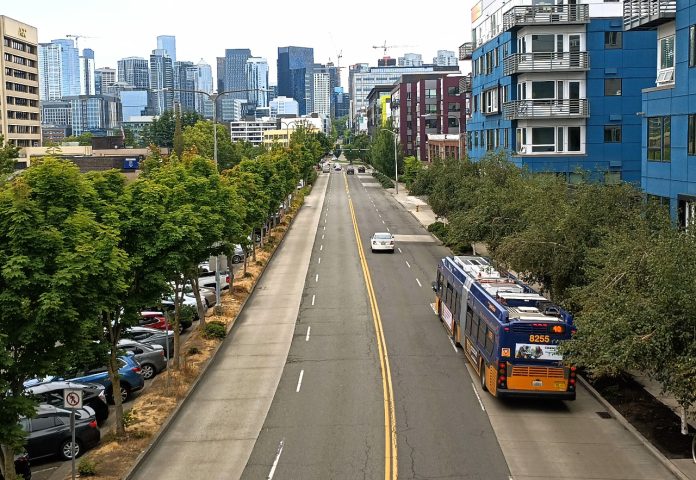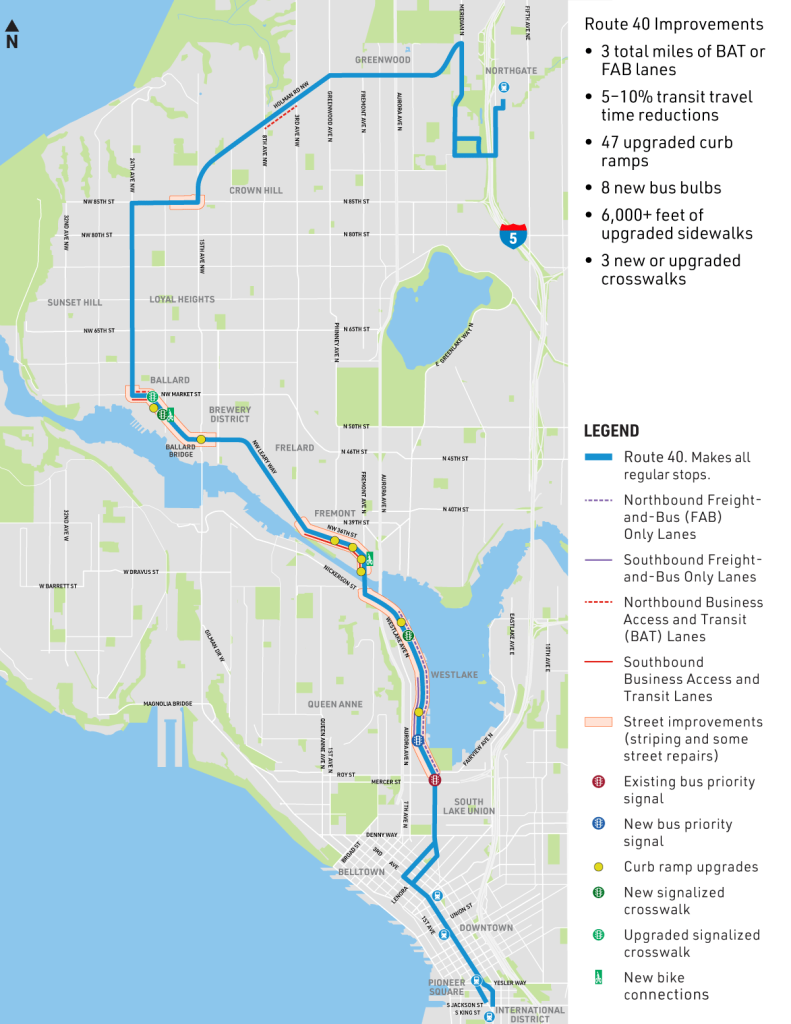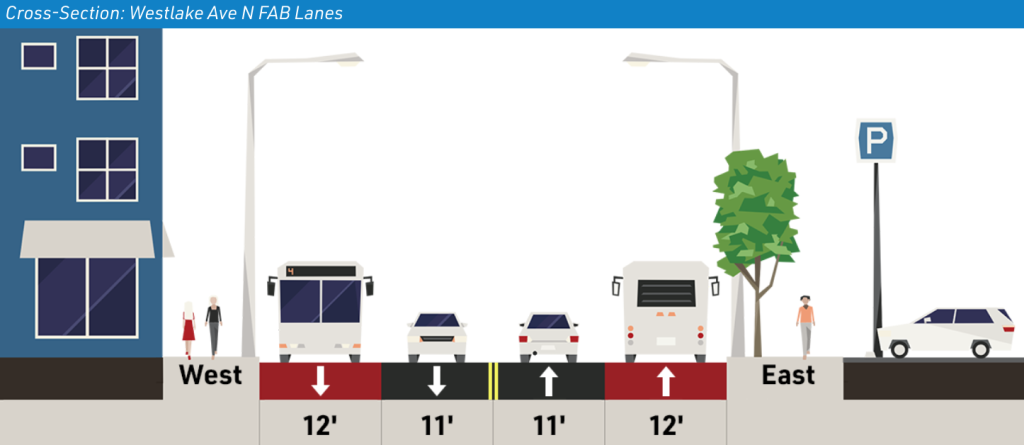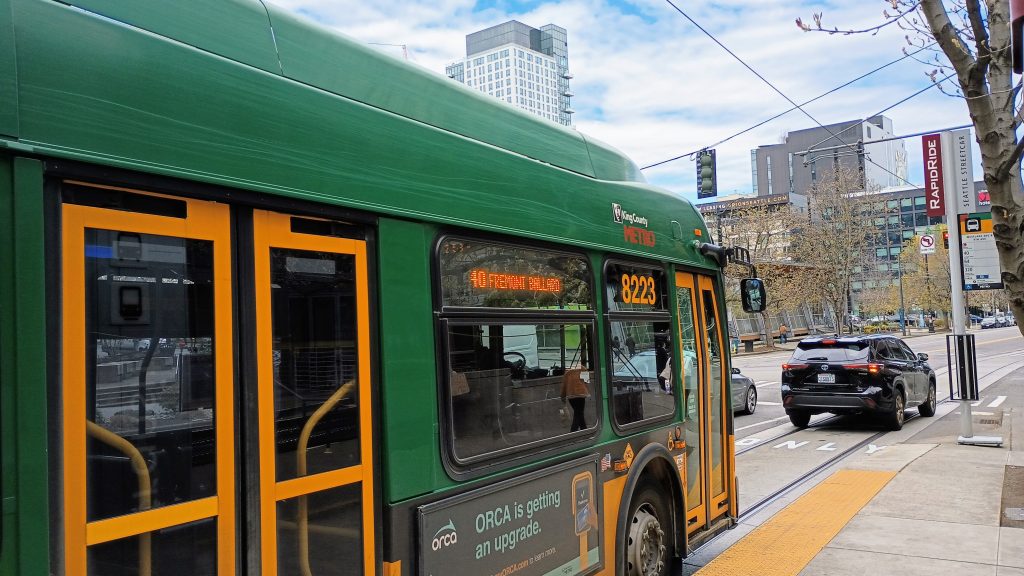
The Seattle Department of Transportation (SDOT) has reached full design on a set of upgrades to Route 40, one of the city’s busiest crosstown routes that connects Northgate, Greenwood, Ballard, Fremont, and downtown Seattle. Scaled back from the full corridor upgrades promised to voters in 2015’s Move Seattle Levy, the improvements will alleviate some of the route’s most persistent bottlenecks and provide dedicated transit lanes along a substantial segment.
The project is moving forward in the face of sustained opposition from local business and industrial groups questioning the need for 24/7 bus priority along Westlake Avenue N and Leary Way NW among other streets, and other changes that prioritize transit rider experience over current street uses like curbside parking.
SDOT expects the new Route 40 to see up to a 10% decrease in total travel time between Northgate and Downtown, and for trips to become more reliable, avoiding “bus bunching” that is currently very common on the Route 40. Only two out of every three Route 40 trips are arriving on time during the 3pm to 7pm timeframe on weekdays when ridership demands are at their highest, according to recent King County Metro figures.

Ridership on the route over the latter half of 2023 has hovered around 7,500 rides per weekday, a big drop from the 12,000 the route saw in late 2019. Still, it remains among the highest ridership figures seen in North Seattle, higher than the workhorse Route 44 and on par with West Seattle’s RapidRide C Line.
In its announcement that design had reached 100%, SDOT noted the considerable amount of outreach that had been done around the city’s plans: more than 40 briefings, six surveys, seven tabling events, and numerous door-to-door engagement opportunities since the project launched over three years ago. It also noted changes that had been prompted thanks to that outreach, including added loading zones.
The biggest change that was prompted by responding to community feedback over the past few years is a first-of-its-kind pilot of transit-only lanes that will be able to be used by large freight vehicles as well. Along Westlake Avenue N, vehicles moving freight that are over 26,000 pounds in weight will be able to use the transit lanes at any time of day, and the results of this pilot will inform any future rollout of a freight-and-bus (FAB) lane elsewhere in the city, which has been contemplated by SDOT.

The project also doesn’t reduce the number of loading zones that businesses can use, and in some cases is actually adding new loading zones in both Fremont and along Westlake Avenue.
But attacks on the project have assailed the most central elements of the upgrades. This past June, a group of business advocates sent a letter to SDOT Director Greg Spotts asking that the project be paused until “significant issues” with its design can be addressed. The letter was signed by Pete Hanning, executive director of the Fremont Chamber of Commerce (and at the time, candidate for city council in District 6), Mike Stewart, executive director of the Ballard Alliance, that neighborhood’s primary advocate for business owners, Sooz Appel, a commercial property owner along Westlake Avenue N (and Hanning’s mother), and Eugene Wasserman, president of the North Seattle Industrial Association.
Hanning lost his race against incumbent Councilmember Dan Strauss by a relatively narrow margin of five points. He lacked the endorsement of Mayor Bruce Harrell and the independent expenditure campaigns from corporate leaders that other centrist candidates enjoyed.
Wasserman has been pushing back on the Route 40 project since 2021, when he asked the City to pause the project, asserting that SDOT was willing to sacrifice the viability of maritime and industrial businesses “so that Amazon workers can get to their offices five minutes earlier.” Wasserman has been involved in the multi-year fight to keep the Burke-Gilman’s Missing Link off Shilshole Avenue NW as part of the “Ballard Coalition” that has kept the issue mired in lawsuits, and was an outspoken critic of the Move Seattle Levy during 2015’s ballot campaign.
In 2021, Wasserman suggested other business advocacy groups like the Ballard Alliance were on his side in opposing the Route 40 project, but The Urbanist could not confirm the alliance’s opposition at the time. Earlier this year, the Fremont Chamber of Commerce held a meeting of local business owners focused on Route 40, after a series of emails sent to its members painted a dire picture for them. “Be Warned! Traffic in Fremont could get much worse,” one email read. (Neither Hanning nor Stewart returned a request for comment from The Urbanist.)
This June’s letter cited lower ridership on Route 40 compared to pre-pandemic levels as a justification for removing dedicated transit lanes from the project. “Even when ridership was at its height, there have been no issues of congestion or delays for busses on Westlake N. Bus only lanes are a solution to a non-problem and should be removed from the plan,” it read.

Seattle’s climate action plan, which calls for a considerable reduction in the number of vehicle miles traveled by Seattle residents via a shift to other travel modes, was brought up in defense of removing those transit-only lanes from the plans.
“As we know, transportation is the largest source of carbon pollution in our state, contributing roughly 22% of total air pollution and 39% of greenhouse gas emissions throughout the state,” the business groups wrote. “By creating a scenario where we’re adding dedicated bus lanes for buses that are at 50% capacity and at the same time adding significantly to traffic idling times does not seem to meet our city’s carbon reduction goals.”
The letter also uses the recent move by Councilmember Strauss to study moving the alignment of the Burke-Gilman Missing Link to Leary Way NW as one reason to pause the bus improvements, citing a “compounding impact” on the area. Opponents of having the trail on Shilshole have long wanted to move the trail to Leary, but SDOT has asserted that the two projects are not in conflict.
But while SDOT has made substantial tweaks to the project in response to feedback, the elements of the project providing transit priority appear to be moving forward at full steam. With the project reaching 100% design, there will be limited opportunities to change any more elements in the project. The department, however, has made a commitment “to business and property owners to observe traffic patterns after project completion and keep them engaged about findings and their experience.”
But while the project’s detractors have been particularly loud, it does have strong supporters as well.
“Ballard-Fremont Greenways strongly supports the 100% design for the Route 40 TPMC,” Ankur Dhoot said on behalf of the safe streets advocacy group. “This project has been updated significantly in response to community and stakeholder feedback and represents a modest transportation project that will tangibly improve connectivity, safety, and sustainability in some of Seattle’s fastest-growing neighborhoods. We are confident that the final design of the project meets the stated goals to ‘reduce transit travel times, improve transit reliability, and increase safety and transit access along the Route 40 corridor.’ We look forward to construction and final project completion.”
Nothing is final until construction starts, but all signs point toward this critical upgrade for one of the city’s most important bus corridors moving forward.
Ryan Packer has been writing for The Urbanist since 2015, and currently reports full-time as Contributing Editor. Their beats are transportation, land use, public space, traffic safety, and obscure community meetings. Packer has also reported for other regional outlets including BikePortland, Seattle Met, and PubliCola. They live in the Capitol Hill neighborhood of Seattle.

